Dynamic Data Optimization in IoT-Assisted Sensor Networks on Cloud Platform
2022-08-24NguyenTuanAkilaSouvikPalBikramjitSarkarThienKhaiTranMothilalNehruandDacNhuongLe
Nguyen A.Tuan, D.Akila, Souvik Pal, Bikramjit Sarkar, Thien Khai Tran,G.Mothilal Nehruand Dac-Nhuong Le
1Faculty of Information Technology, Ho Chi Minh City University of Foreign Languages-Information Technology, Ho Chi Minh City, 70000, Vietnam
2Department of Information Technology, Vels Institute of Science, Technology & Advanced Studies, Chennai, 600117,India
3Department of Computer Science and Engineering, Sister Nivedita University, Kolkata, 700156, India
4Department of Computer Science and Engineering, JIS College of Engineering, Nadia, 741235, India
5Institute of Research and Development, Duy Tan University, Danang, 550000, Vietnam
6School of Computer Science, Duy Tan University, Danang, 550000, Vietnam
Abstract: This article presents a new scheme for dynamic data optimization in IoT (Internet of Things)-assisted sensor networks.The various components of IoT assisted cloud platform are discussed.In addition, a new architecture for IoT assisted sensor networks is presented.Further, a model for data optimization in IoT assisted sensor networks is proposed.A novel Membership inducing Dynamic Data Optimization Membership inducing Dynamic Data Optimization (MIDDO) algorithm for IoT assisted sensor network is proposed in this research.The proposed algorithm considers every node data and utilized membership function for the optimized data allocation.The proposed framework is compared with two stage optimization, dynamic stochastic optimization and sparsity inducing optimization and evaluated in terms of reliability ratio, coverage ratio and sensing error.Data optimization was performed based on the availability of cloud resource, sensor energy, data flow volume and the centroid of each state.It was inferred that the proposed MIDDO algorithm achieves an average performance ratio of 76.55%, reliability ratio of 94.74%, coverage ratio of 85.75% and sensing error of 0.154.
Keywords: Data optimization; IoT; sensor network; reliability; membership;sensor energy
1 Introduction
With the recent revolution in the field of internet technology, big data analysis has become a trending research area.The main limitation of this domain is the excessive storage requirements due to the bulk of data involved in IoT systems [1].The IoT sensors collect huge amount of raw data and transfer them to the cloud using a transport layer.The data in the cloud is analyzed by the cloud servers for further processing [2].The processed data is transferred back to the cloud.This process creates severe delay due to the high volume of the data.Hence data optimization is an essential task [3].Quantum computing is a popularly used technique for data optimization.This involves two systems namely tangible and intangible.Tangible systems include manufacturing defects and intangible systems include sensor defects [4].IoT systems are powered using wireless technologies.In these systems the main aim of data optimization is to decrease the age of information [5].The main advantage of data optimization is the reduction in the energy consumption.To support this non-orthogonal multiple access systems are popularly being employed [6].The life of the IoT devices is enhanced by the employment of wireless power transfer technology.This technology aids in the transfer of energy in specific time slots to maximize the efficiency [7].Another advantage of data optimization is the efficient data acquisition.This is because of two improvements namely in the domain of data redundancy and in the domain of energy consumption [8].Compressive sensing is used for compressing the acquired data so that the bulk of data transfer can be reduced.In addition,the compressed data can be recovered back using suitable recovery systems [9].Thus, data optimization helps to achieve energy efficient, reliable transfer of IoT data with minimal delay.Further, the overall cost requirements are also minimized with these schemes [10].
The large number of wireless devices, such as smart phones and the Internet of Things (IoT), has resulted in the wireless network business producing and collecting an unprecedented amount of data in recent years, owing to the exponential development in mobile traffic seen in recent years.The above discussion shows the importance of data optimization in IoT sensor networks.Hence, in this research,we present a new model for data optimization based on membership inducing technology.
Based on the idea of data optimization gained from the detailed literature survey, a new scheme called Membershipinducing Dynamic Data Optimization(MIDDO)algorithm for IoTassisted sensor network is proposed in this research.
The main objective of the proposed research is to present a scheme for data optimization in IoT assisted sensor networks.The system is to be designed such that the data is optimized along with minimal energy loss and maximum reliability.
The contributions of this paper are as follows:
■The various components of IoT assisted cloud platform are discussed.
■Architecture of IoT assisted sensor networks is discussed.
■Data optimization in IoT assisted sensor networks is presented.
■A novel Membership inducing Dynamic Data Optimization (MIDDO) algorithm for IoT assisted sensor network is proposed.
■Proposed framework is evaluated in terms of performance ratio, reliability ratio, coverage ratio and sensing error.
In Section 2, we have discussed the background study data optimization and analytics in Cloud-IoT Systems.In Section 3, we have discussed modeling on IoT Assisted Cloud Platform, the system design and data optimization of IoT Assisted Cloud Platform, Membership Inducing Dynamic Data Optimization (MIDDO) algorithm.Section 4 illustrates the Numerical Analysis, results, and discussion part.Section 5 concludes the work.
2 Related Works
This section deals with the background study for IoT supported sensor networks.Data optimization techniques can be made understood through a thorough literature review.The main goal is to develop a data optimization technique for IoT supported sensor networks.The system must be built to optimize data while minimizing energy loss and ensuring optimal reliability.Yang et al.[11] has proposed a system in which the real time data optimization was done based on clustering model.Here, dynamic transportation technique was used for optimal allocation of resources.The input database of IoT systems was optimized and various parameters like performance and economic cost were evaluated.Vimal et al.[12] has presented a scheme for energy enhancement based on ant colony optimization technique.Clustering was performed based on data aggregation to support optimization.This clustering technique was done such that the energy constrained devices support enhanced data utilization.Li et al.[13] has designed a scheme for optimization of IoT devices based on block chain.This system utilized edge computing technique for the joint optimization.Security aspects of block chain were enhanced in this system along with the reduction in energy requirements.Thus, delay tolerant data was achieved in this system.Irshad et al.[14] has proposed a framework for the optimization of performance of biological systems using IoT network.Here, deep learning was utilized for achieving optimization.The huge bulk of biological data collected using IoT sensors were optimized to prevent the loss or damage of sensitive data.Chen et al.[15] has designed a technique for the minimization of lost energy in unmanned aerial vehicle systems.Further, the loss of transmitted data is also minimized by the effective optimization of IoT devices.Swarm optimization technique was employed here to achieve dynamic optimization.Al Shorman et al.[16] has presented a scheme in which support vector machine was utilized to achieve optimization of IoT data.This system was designed to protect the IoT data from the distributed denial of service attack.
Further, evolutionary optimization technique was proposed to effectively allocate the IoT resources.Iwendi et al.[17] has presented a framework for the optimization of energy using a metaheuristic approach.The amount of energy consumed by the IoT sensors are minimized using this technique based on cluster head selection technique.The main advantage was the increase in the life time of the IoT sensors.Hossain et al.[18] has presented a technique for simultaneous optimization and compression of IoT data.This technique is designed for implementation by smart decision systems.Fog and edge computing techniques were evaluated for the data optimization to achieve sensor efficiency.Côrte-Real et al.[19] has proposed a model for the big data analytics.Here, the IoT data generated based on European and American firms were collected and used for analysis.Partial least square technique was used for the data optimization.Azar et al.has designed a scheme for data compression to achieve energy efficient system in IoT data transfer.Edge machine learning algorithm was used for the compression of data.Moreover, time saving and improved privacy was achieved by this system.The transmitted data was constructed over the edge node in this framework to achieve optimization of data [20-25].
3 Proposed Framework
3.1 Components of IoT Assisted Cloud Platform
The main components of the IoT assisted cloud platform are the data monitoring, data analysis,data optimization and data prediction.
Fig.1 illustrates the components of the IoT assisted cloud platform.The first main component is the data monitoring.The parameters of the IoT sensors are monitored in real-time by the IoT assisted cloud platform.This is a crucial component especially in case ofmedical IoT sensors related to healthcare.It is also used in other platforms like industrial platform, agricultural sector etc.The next main component is the data analysis.The analysis of IoT data is done for classification.Classification is essential so that the system can be improved based on machine learning algorithms.The third main component is the data optimization.Since the data generated by the IoT systems are huge, it is called as big data.The two main challenges of the big data are the data storage and data processing.To address these two issues, data optimization is a must.The last component is the data prediction.Prediction helps to predict the future variables that can be useful to make various decisions.The various layers in the architecture of IoT assisted sensor network is discussed in the following section.

Figure 1: Components of IoT assisted cloud platform
3.2 Architecture of IoT Assisted Sensor Networks
The architecture of IoT assisted sensor networks comprises of three main layers that include the sensing layer, transport layer and the application layer.
Fig.2 illustrates the architecture of IoT assisted sensor networks.The bottom most layer is the sensing layer.This layer includes all the IoT sensor nodes.These nodes include physical devices that collect various real time data and transmit those using wireless technologies like RFID (Radio Frequency Identification), Wi-Fi etc.The second layer is termed as the transport layer.This layer is used for transferring the data acquired by the sensing layer to the cloud.The final layer is the application layer that includes cloud, servers, processors and users.This layer is responsible for providing application-based services to all the users of the network.Important component of this layer is data optimization.This is discussed in the next section.
3.3 Data Optimization in IoT Assisted Sensor Networks
Data optimization is essential for optimizing the resource allocation to various components of the cloud system.
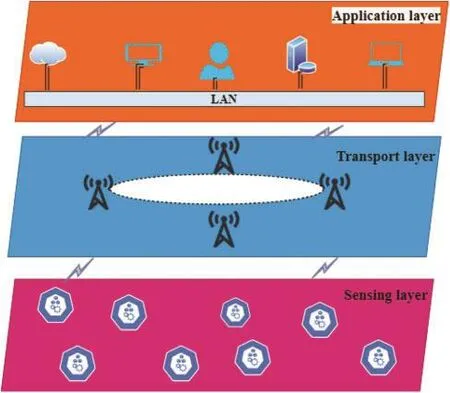
Figure 2: Architecture of IoT assisted sensor networks
Fig.3 depict the data optimization scheme in the IoT assisted sensor networks.In these systems,the first group of devices are the IoT based smart devices.These devices continuously collect real time data through different equipment.With the development of internet technology various devices are equipped and connected to the IoT framework.The collected data are huge.This data is transferred to the IoT cloud.From the IoT cloud, the sensor data is transferred to the storage devices.Again, from the storage device the data is transferred to the processing unit.The processing unit performs the task of data optimization.

Figure 3: Data optimization in IoT assisted sensor networks
Fig.4 indicates the proposed membership inducing dynamic data optimization (MIDDO) model.The bottom layer of the model has the IoT sensor network.It includes smart houses, smart cameras,smart phones, smart surveillance systems, smart mills, smart irrigation, smart transportation etc.This data is then optimized using the proposed MIDDO model.The optimized data is then transferred to the cloud.The optimized data has better data rate, better reliability and minimal storage requirements.

Figure 4: Proposed membership inducing dynamic data optimization model
3.4 Proposed Membership Inducing Dynamic Data Optimization (MIDDO) Algorithm for IoT Assisted Sensor Network
The proposed Membership inducing Dynamic Data Optimization (MIDDO) algorithm for IoT assisted sensor network is given below.
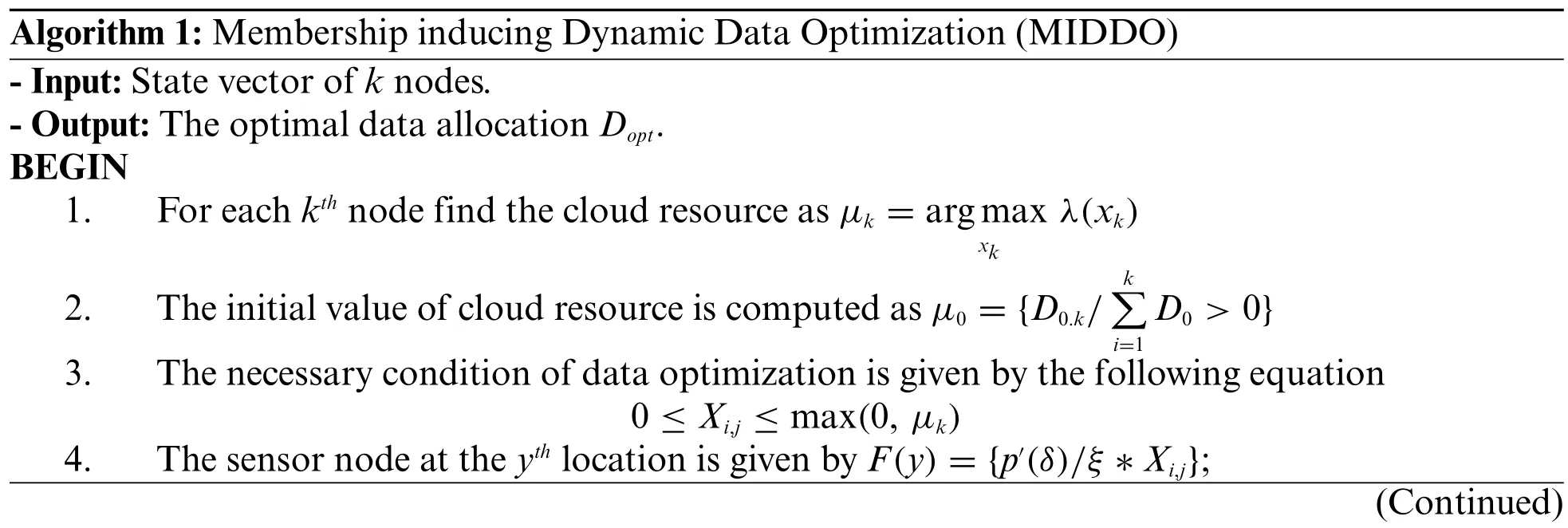
Algorithm 1: Membership inducing Dynamic Data Optimization (MIDDO)- Input: State vector of k nodes.- Output: The optimal data allocation Dopt.BEGIN 1.For each kthnode find the cloud resource as μk= argmax xk λ(xk)2.The initial value of cloud resource is computed as μ0= {D0.k/k∑i=1 D0>0}3.The necessary condition of data optimization is given by the following equation 0≤Xi,j≤max(0,μk)4.The sensor node at the ythlocation is given by F(y) = {p′(δ)/ξ* Xi,j};(Continued)
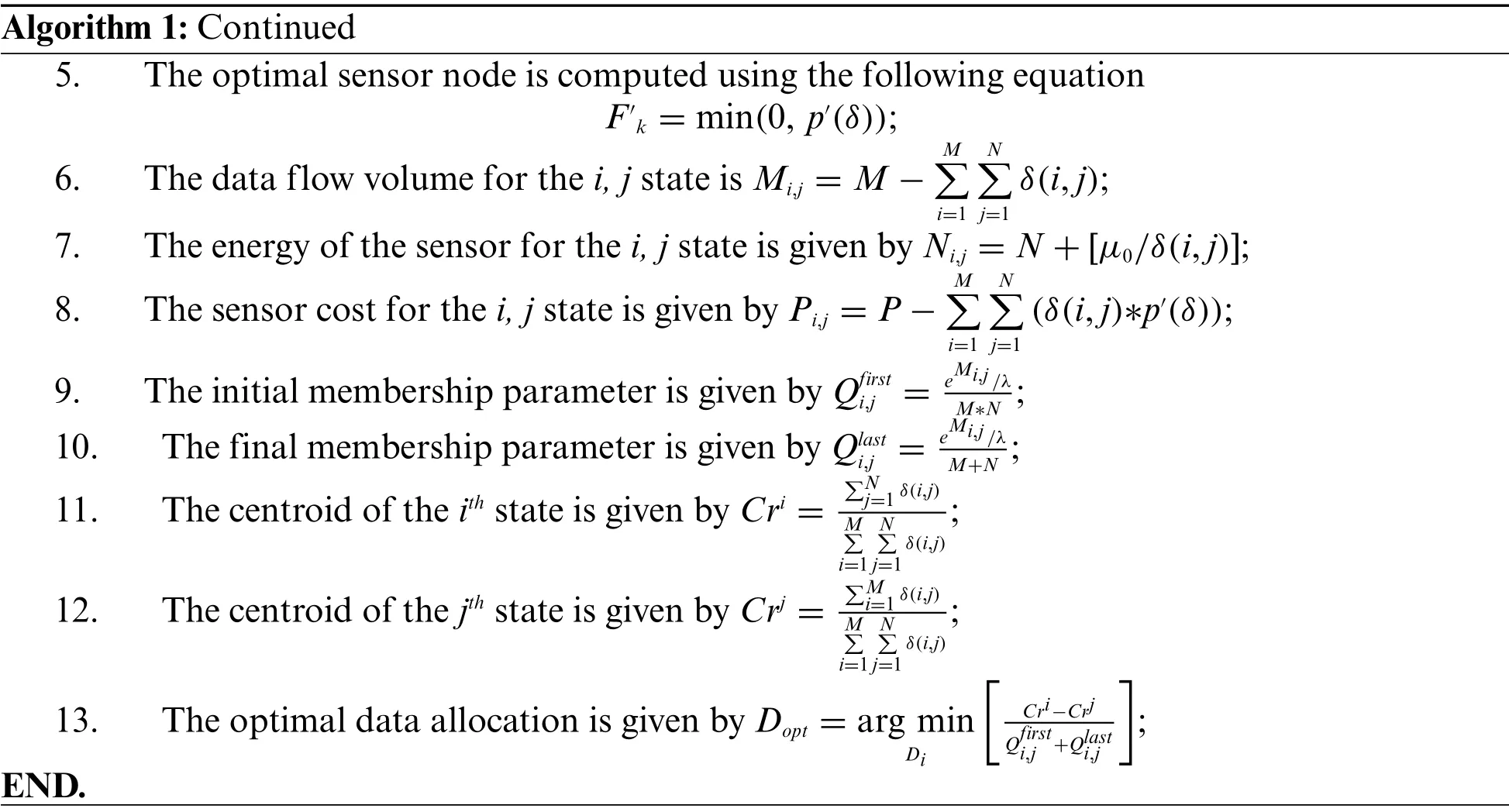
Algorithm 1: Continued 5.The optimal sensor node is computed using the following equation F′k= min(0, p′(δ));6.The data flow volume for the i, j state is Mi,j= M -M∑i=1j=1 N∑δ(i,j);7.The energy of the sensor for the i, j state is given by Ni,j= N + [μ0/δ(i,j)];8.The sensor cost for the i, j state is given by Pi,j= P -M∑i=1j=1 N∑(δ(i,j)*p′(δ));9.The initial membership parameter is given by Qfirsti,j =eMi,j/λ M*N;10.The final membership parameter is given by Qlasti,j=eMi,j/λ M+N;11.The centroid of the ithstate is given by Cri=∑N j=1δ(i,j)M∑i=1j=1 N∑δ(i,j);12.The centroid of the jthstate is given by Crj=∑M i=1δ(i,j)M∑i=1j=1 N∑δ(i,j);13.The optimal data allocation is given by Dopt= arg min Diimages/BZ_1331_1530_1306_1555_1352.pngCri-Crj Qfirst i,j+Qlasti,jimages/BZ_1331_1706_1306_1731_1352.png;END.
The explanation of the proposed algorithm is given below.
For eachkthnode find the cloud resource as

where,μkis the cloud resource of thekthnode,xkis the state vector of thekthnode and λ(xk) represents the overall state momentum of thexknode.The termidentifies the value of state vector that gives maximum value of overall state momentum.Thus, the cloud resource identification is done in the first step in the optimization of cloud data.The initial value of cloud resource is computed as,

where μ0is the initial cloud resource value,D0.kis the incidence ratio for the kth node,D0is the initial incidence ratio,D0>0 refers to condition where the incidence ratio is greater than zero, the term>0 refers to sum of the states when the incidence ratio is greater than zero and>0}gives the value of incidence ratio of thekthnode, given the total incidence ratio is greater than zero.The necessary condition of data optimization is given by the following equation,

This condition denotes that the non-repeatable data for thei, jstate must be in between zero and max(0,μk).The term max(0,μk) refers to the cloud resource of thekthnode if it is greater than zero.The sensor node at theythlocation is given by

whereF(y) refers to sensor node at theythlocation,p′(δ) is the coverage area of theF(y) sensor,ξ is the data rate,Xi,jis the non-repeatable data for thei, jstate.The termp′(δ)/ξ*Xi,jgives the ratio of the of the coverage area of theF(y) sensor to the product of the data rate and non-repeatable data for thei, jstate.The optimal sensor node is computed using the following equation.

whereF′kis the optimal sensor node identifier,p′(δ) is the coverage area of theF(y) sensor, the term min(0,p′(δ)) refers to the coverage area of theF(y) sensor if its less than zero.The data flow volume for thei, jstate is

Here,Mi,jis the data flow volume for thei, jstate,Mis the initial data flow volume and δ(i,j) is the server space for thei, jstate and the termδ(i,j) gives the total server space for all the states.The energy of the sensor for thei, jstate is given by

whereNi,jis the energy of the sensor for thei, jstate,Nis the initial sensor energy,μ0is the energy coefficient and δ(i,j) is the server space for thei, jstate.The term μ0/δ(i,j) gives the ration of energy coefficient to the server space.The sensor cost for thei, jstate is given by

Here,Pi,jis the sensor cost for thei, jstate,Pis the initial cost and δ(i,j) is the server space for thei,jstate.The termp′(δ) gives the coverage area.The term(δ(i,j) *p′(δ)) gives the total coverage volume of all the sensors.The initial membership parameter is given by



whereCriis the centroid of theithstate,δ(i,j) is the server space for thei, jstate, the termgives the server space for all theistates andδ(i,j) gives the overall server space.The centroid of thejthstate is given by

whereCrjis the centroid of thejthstate,δ(i,j) is the server space for thei, jstate, the termδ(i,j)gives the server space for all theistates andδ(i,j) gives the overall server space.The optimal data allocation is given by

where,Doptis the optimal data allocation,Criis the centroid of theithstate,Crjis the centroid of thejthstate,is the initial membership parameter andis the final membership parameter.
3.5 Challenges of Proposed MIDDO Model
The main challenge of the proposed MIDDO model is the vulnerability to security attacks.The optimization algorithms can be compromised by the attackers to create threats to the entire IoT framework.
3.6 Benefits of Proposed MIDDO Model
The main advantage of this MIDDO model is the increase in reliability of the system.In addition,the overall sensing error is reduced with the proposed framework.Further, another main advantage is the increase in coverage ratio and performance ratio.
4 Results and Discussion
The proposed methodology analyses various parameters like performance ratio, reliability ratio,coverage ratio and sensing error.These are discussed in this section.Comparison is done with other data optimization techniques like two stage optimization (TSO), dynamic stochastic optimization(DSO) and sparsity inducing optimization (SIO).
Tab.1 shows the variation of performance ratio for 12 different sensor nodes using two stage optimization, dynamic stochastic optimization, sparsity inducing optimization and the proposed MIDDO algorithm.It is clear from Tab.1 that the mean value of performance ratio achieved by two stage optimizations is 47.97%.Dynamic stochastic optimization achieved a mean value of 55.94% and sparsity inducing optimization produces a mean performance ratio of 36.41%.However, the proposed MIDDO algorithm achieves a mean performance ratio of 76.55% for the 12 sensor nodes.Thus, we find that the proposed system produces best results.This is due to the fact that the proposed system employs cloud resource allocation as a main criterion.

Table 1: Variation of performance ratio
Tab.2 shows the variation of reliability ratio for 12 different sensor nodes using two stage optimization, dynamic stochastic optimization, sparsity inducing optimization and the proposed MIDDO algorithm.

Table 2: Variation of reliability ratio
It is clear from Tab.2 that the mean value of reliability ratio achieved by two stage optimizations is 70.77%.Dynamic stochastic optimization achieved a mean value of 85.54% and sparsity inducing optimization produces a mean reliability ratio of 66.76%.However, the proposed MIDDO algorithm achieves a mean reliability ratio of 94.74% for the 12 sensor nodes.Thus, we find that the proposed system produces best results in terms of reliability.This high value of reliability ratio is due to the contribution of membership functions in the computation of data optimization.
Tab.3 shows the variation of coverage ratio for 12 different sensor nodes using two stage optimization, dynamic stochastic optimization, sparsity inducing optimization and the proposed MIDDO algorithm.It is clear from Tab.3 that the mean value of coverage ratio achieved by two stage optimizations is 65.70%.Dynamic stochastic optimization achieved a mean value of 76.04% and sparsity inducing optimization produces a mean coverage ratio of 56.37%.However, the proposed MIDDO algorithm achieves a mean coverage ratio of 85.75% for the 12 sensor nodes.Thus, we find that the proposed system produces best results in terms of coverage.This is because the proposed data optimization is directly proportional to data flow volume value.

Table 3: Variation of coverage ratio
Tab.4 shows the variation of sensing error for 12 different sensor nodes using two stage optimization, dynamic stochastic optimization, sparsity inducing optimization and the proposed MIDDO algorithm.It is clear from Tab.4 that the mean value of sensing error achieved by two stage optimizations is 0.524.Dynamic stochastic optimization achieved a mean value of 0.353 and sparsity inducing optimization produces a mean sensing error of 0.633.However, the proposed MIDDO algorithm achieves a mean sensing error of 0.154 for the 12 sensor nodes.Thus, we find that the proposed system produces best results in terms of sensing error.The least value of sensing error is due to the fact that the proposed system ensures the location of the optimized data to be placed at the center of theithandjthcentroid.

Table 4: Variation of sensing error
Fig.5 shows the variation of data flow volume for 12 different sensor nodes using two stage optimization, dynamic stochastic optimization, sparsity inducing optimization and the proposed MIDDO algorithm.It is evident from Fig.5 that the mean value of data flow volume achieved by two stage optimizations is 833.58.Dynamic stochastic optimization achieved a mean value of 889.91 and sparsity inducing optimization produces a mean data flow volume of 672.16.However, the proposed MIDDO algorithm achieves a mean data flow volume of 1158.83 for the 12 sensor nodes.Thus, we find that the proposed system produces best results in terms of data flow volume.The highest value of data flow volume is because of the inclusion of coverage ratiop′(δ) in the MIDDO algorithm.
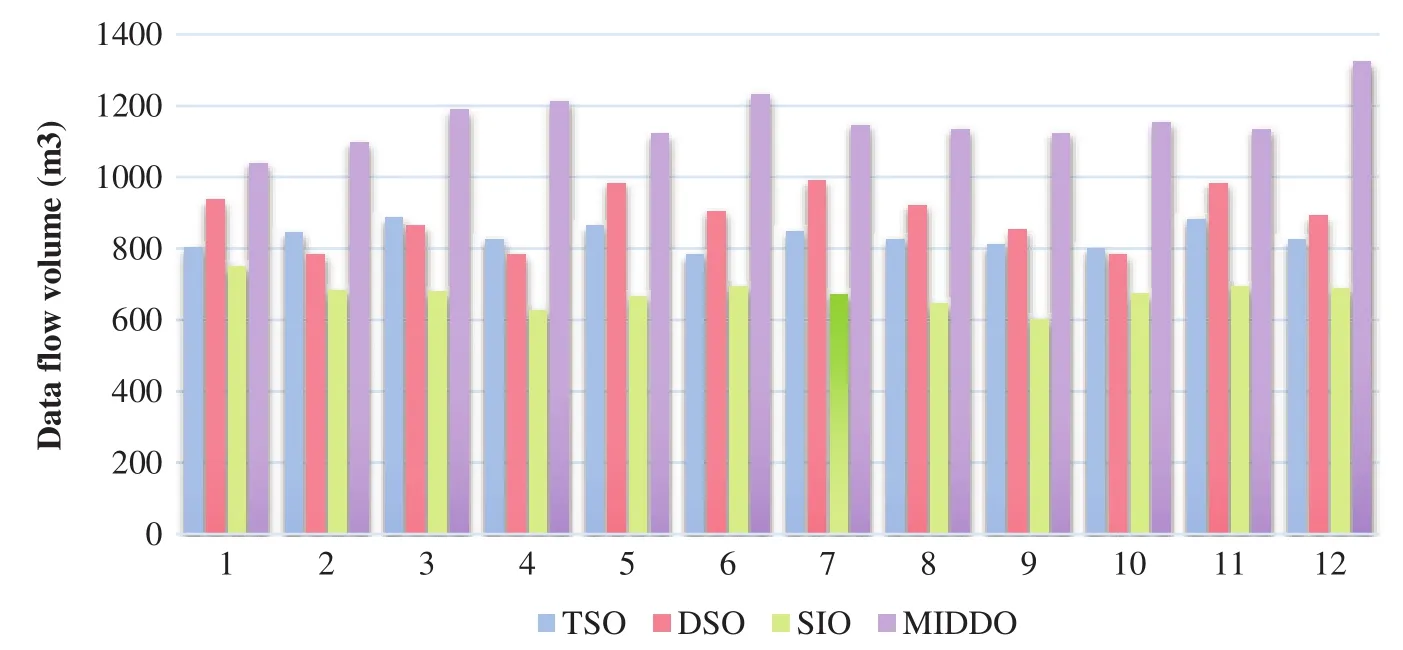
Figure 5: Variation of data flow volume
Fig.6 shows the variation of sensor energy for 12 different sensor nodes using two stage optimization, dynamic stochastic optimization, sparsity inducing optimization and the proposed MIDDO algorithm.It is evident from Fig.6 that the mean value of sensor energy achieved by two stage optimizations is 55.33%.Dynamic stochastic optimization achieved a mean value of 64.66%and sparsity inducing optimization produces a mean sensor energy of 53.25%.However, the proposed MIDDO algorithm achieves a mean sensor energy of 36.33% for the 12 sensor nodes.Thus, we find that the proposed system produces best results in terms of sensor energy.The highest value of sensor energy is because the optimized data directly depends on the incidence ratioD0.k.

Figure 6: Variation of sensor energy
Fig.7 shows the variation of initial membership for 12 different sensor nodes using two stage optimization, dynamic stochastic optimization, sparsity inducing optimization and the proposed MIDDO algorithm.It is evident from Fig.7 that the mean value of initial membership achieved by two stage optimizations is 45.66%.Dynamic stochastic optimization achieved a mean value of 50.91%and sparsity inducing optimization produces an initial membership of 34.91%.However, the proposed MIDDO algorithm achieves initial membership of 84.16% for the 12 sensor nodes.Thus, we find that the proposed system produces best results in terms of initial membership.The highest value of initial membership is because of the proposed system considers the first membership value for resource allocation.

Figure 7: Variation of initial membership
Fig.8 shows the variation of final membership for 12 different sensor nodes using two stage optimization, dynamic stochastic optimization, sparsity inducing optimization and the proposed MIDDO algorithm.It is evident from Fig.8 that the mean value of final membershipachieved by two stage optimizations is 45.16%.Dynamic stochastic optimization achieved a mean value of 54.2%and sparsity inducing optimization produces a final membership of 31.91%.However, the proposed MIDDO algorithm achieves a mean final membership of 56.91% for the 12 sensor nodes.Thus, we find that the proposed system produces best results in terms of final membership.The highest value of finalmembership is because the proposed MIDDO algorithm considers last membership value along with initial value for resource allocation.

Figure 8: Variation of final membership
Fig.9 shows the variation of optimal data allocation for 12 different sensor nodes using two stage optimization, dynamic stochastic optimization, sparsity inducing optimization and the proposed MIDDOalgorithm.It is evident fromFig.9 that themean value of optimal data allocation achieved by two stage optimizations is 45.66%.Dynamic stochastic optimization achieved a mean value of 50.91% and sparsity inducing optimization produces a mean optimal data allocation of 34.91%.However, the proposed MIDDO algorithm achieves a mean optimal data allocation of 85.16% for the 12 sensor nodes.Thus,we find that the proposed system produces best results in terms of optimal data allocation.The highest value of optimal data allocation
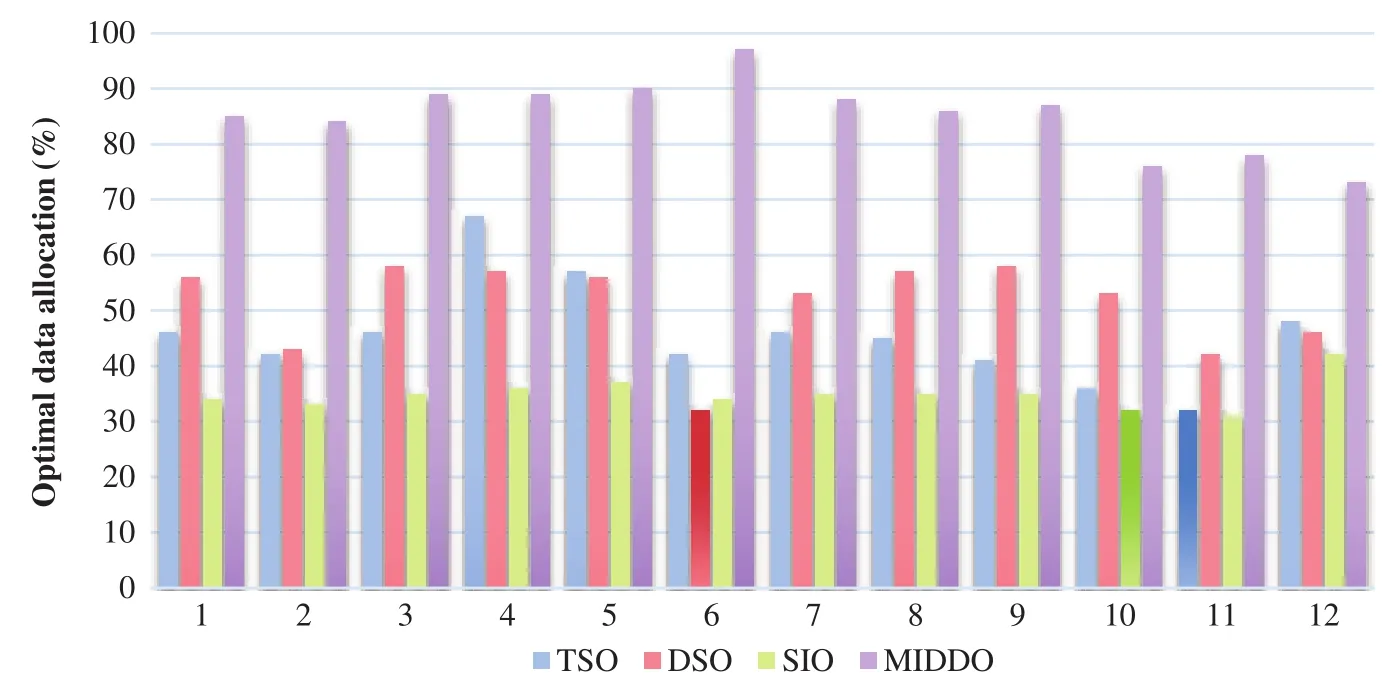
Figure 9: Variation of optimal data allocation
5 Conclusion
This paper presented a new algorithm called Membership inducing Dynamic Data Optimization(MIDDO) algorithm for the IoT data optimization.Here, the data optimization was performed based on the availability of cloud resource, sensor energy, data flow volume and the centroid of each state.The optimized data can be used for reducing the storage requirements and data rate of the IoT system.The advantages and limitations of the proposed MIDDO model were also discussed.
Further, the proposed system was compared with two stage optimization, dynamic stochastic optimization and sparsity inducing optimization in terms of data flow volume, sensor energy, initial membership, final membership and optimal data allocation.It was deduced that the proposed model achieved a mean data flow volume of 1158.83, mean sensor energy of 53.25%, initial membership of 84.16%, meanfinal membership of 56.91% and mean optimal data allocation of 85.16% for 12 sensor nodes.
In future, we have planned to implement the proposed system in IoT nodes and evaluate the energy saved and efficiency achieved based on real-time IoT data.Different IoT-based sensing parameters are required to be significant accumulations for engineers and organizations.In this context, energyefficient algorithms can be future study of this manuscript.
Funding Statement:The authors received no specific funding for this study.
Conflicts of Interest:The authors declare that they have no conflicts of interest to report regarding the present study.
杂志排行
Computers Materials&Continua的其它文章
- Constructing Collective Signature Schemes Using Problem of Finding Roots Modulo
- Modeling and Simulation of Two Axes Gimbal Using Fuzzy Control
- Artificial Monitoring of Eccentric Synchronous Reluctance Motors Using Neural Networks
- An Optimal Scheme for WSN Based on Compressed Sensing
- Triple-Band Metamaterial Inspired Antenna for Future Terahertz (THz)Applications
- Adaptive Multi-Cost Routing Protocol to Enhance Lifetime for Wireless Body Area Network
